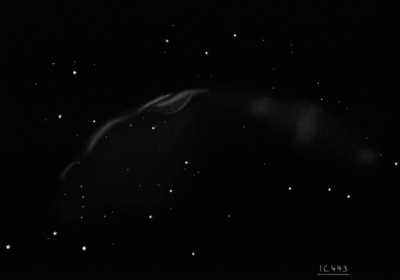Gem A
Gem A

Max Wolf discovered IC 443, along with IC 444, on 25 Sep 1892 with a 2 1/4" lens. In AN 3130 (1892), he recorded finding "[Two] Very large and bright nebulous masses are visible there [near Mu and Eta Geminorum], which very roughly have their centers at approximately 6h 14m +24° IC 444] and 6h 08m +22° [IC 443]."
E.E. Barnard independently discovered these two nebulae in 1894. He reported in "Astronomy and Astro-Physics", Vol 8, No. 3, "On this same plate [taken on 1 Feb 1894 with a 2h 10m exposure] is a faint narrow curved nebulosity in about, 1860.0, 6h 8m + 23° 0'. It is nearly 1/2° long, extending north and south and convex to the east."
300/350mm - 13.1" (1/18/85): at 62x with filter, appears as a very faint elongated strip of nebulosity, perhaps 10' in length. Not visible without a filter.
400/500mm - 17.5" (1/16/02): at 64x and OIII filter, the most prominent section of this supernova remnant is a gently curving band of nebulosity oriented NW-SE, ~10'x3' with a well-defined edge along the eastern (bowed-out) boundary. A larger region of low surface brightness haze, ~20' in size, spreads out to the west of the northern end. At the SE end, the band dims and seems to hook to the SW towards a small arrowhead of stars. Located ~2.5 degrees SE of M35 and following mag 3.3 Eta Geminorum.
17.5" (1/20/90): at 82x with OIII filter this supernova remnant appears moderately bright, large, elongated 5:2 NW-SE. Appears a bit larger and brighter at the NW end. Much fainter nebulosity is close south off the west end and a couple of mag 10 stars are superimposed. Surprisingly easy to view with an OIII filter.
Notes by Steve Gottlieb